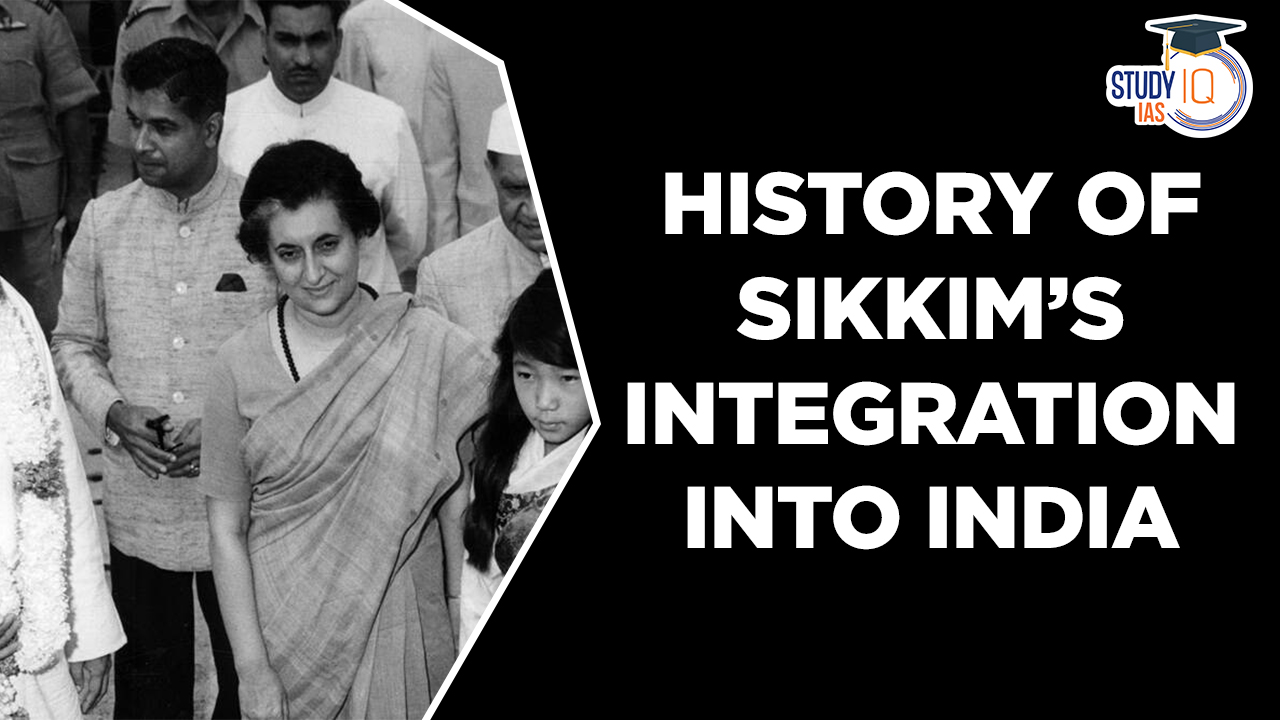Table of Contents
Context: Sikkim day is annually celebrated on May 16, recalling the history of the former kingdom’s integration with India in 1975.
Background: Sikkim’s history with the Chogyal Royals
- The kingdom of Sikkim was established in 1642, when, according to one account, three Tibetan lamas consecrated Phuntsong Namgyal as the first ruler or Chogyal of Sikkim.
- The monarchy of the Namgyal dynasty was maintained for the next 333 years, until its integration with India in 1975.
Sikkim during British Rule
- The British saw Sikkim as a buffer state against China and against Nepal and it enjoyed a degree of autonomy under the suzerainty of British India.
- A formal protectorate was established over Sikkim through the Treaty of Tumlong in 1861.
- It means that the British had control over it, but it was not officially under their rule and the Chogyals could continue holding onto power.
- Other official treaties followed:
- The treaty of Titaliya in 1817 gave the British authorities a number of commercial and political advantages in Sikkim.
- The Calcutta Convention of 1890 demarcated the border between Sikkim and Tibet and was signed by Viceroy Lord Lansdowne and Qing China’s Imperial Associate Resident in Tibet.
- The Lhasa Convention of 1904 affirmed the Calcutta Convention.

Independent India and Sikkim
- After India’s independence, princely states had the option to accede to India or Pakistan.
- During the partition of India in 1947, Sikkim chose to remain an independent country with a special protectorate relationship with India. This arrangement continued until the early 1970s.
- Under this arrangement, Sikkim retained its internal autonomy and had its own monarch, known as the Chogyal. However, India assumed responsibility for Sikkim’s external affairs, defense, and communication.
- Integration process:
- In the early 1970s, there was a growing movement within Sikkim for closer ties with India and a desire to become a state of the Indian Union.
- This movement was led by political parties advocating for the merger of Sikkim with India.
- In April 1973, a referendum was held in Sikkim to determine whether the people wanted Sikkim to continue as an independent state or merge with India.
- The majority of the population voted in favor of joining India. Subsequently, the Sikkim Assembly passed a resolution in favor of Sikkim’s merger with India.
- On May 16, 1975, the Indian Parliament passed the 36th Amendment to the Indian Constitution, which formally recognized Sikkim as the 22nd state of the Indian Union. This amendment abolished the monarchy and established Sikkim as a democratic state within India.
What is the process for formation of a new state?
- According to article 3 of the Constitution, Parliament can form a new state by separating a territory from any state.
- It can also merge two or more states or parts of states. Parliament can also diminish or increase the area, alter the boundary or even change the name of any state.
- Legislative procedure:
- First, a bill on this matter has to be referred by the President to the legislature of the state that will get affected by this reorganisation.
- The state legislature is asked to express its views within a certain period.
- Once the President has ascertained the views of the state government, a resolution is tabled before the assembly.
- If the bill gets passed by the state assembly, the President recommends introduction of a separate bill in Parliament.
- Once passed in Parliament, the bill has to be ratified by the president after which the new state gets officially formed.
How were states organised after Independence in 1947?
- British India had about 600 administrative units in the form of princely states.
- After Independence, these states were given the option to choose between India and Pakistan. Based on geographical, religious and cultural similarities, states opted to go either way.
- Between 1947 and 1950, these states were reorganised to form modern administrative units. A few large states like Mysore, Hyderabad and Bhopal roughly retained their British era boundaries.
How were the states organised when the Constitution came into force?
- When the Constitution came into force on January 26, 1950, India became a union of states (earlier called provinces) with extensive autonomy and union territories administered by the central government.
- There were three kinds of states -nine Part A states, eight Part B states and ten Part C states.
- Part A states were former governor’s provinces in British India -Assam, West Bengal, Bihar, Bombay, Madhya Pradesh, Madras, Orissa, Punjab and Uttar Pradesh.
- Part B states were the former princely states such as Hyderabad, Saurashtra, Mysore, Travancore-Cochin, Madhya Bharat, Vindhya Pradesh, Patiala and East Punjab States Union and Rajasthan.
- Part C states included a few princely states as well as former provinces governed by chief commissioners such as Kutch, Himachal Pradesh, Coorg, Manipur and Tripura. Jammu and Kashmir had special status.
The Chronology of states’ bifurcation in India after 1956
- 1960 – Bombay state split into Maharashtra and Gujarat.
- 1963 – Nagaland carved out of Assam.
- 1966 – Haryana and Himachal Pradesh carved out of Punjab state.
- 1972 – Meghalaya, Manipur and Tripura were formed.
- 1975 – Sikkim became part of Indian union.
- 1987 – Goa and Arunachal Pradesh became states (earlier these were UTs).
- 2000 – Uttaranchal (out of UP), Jharkhand (out of Bihar) and Chhattisgarh (out of Madhya Pradesh) were formed.
- Telangana (out of Andhra Pradesh), when it was eventually created in 2014, became India’s 29 state.
How did language become the basis for organizing states?
- The movement to create states based on language gained momentum in the early 1950s starting with the demand for a separate state for Telugu speaking people.
- In 1952, freedom fighter and Gandhian Potti Sriramulu started his fast demanding the creation of Andhra Pradesh consisting of the Telugu speaking districts of Madras.
- On December 15, which was the 56th day of his fast, Sriramulu died and widespread violence erupted in the Telugu speaking areas of Madras state.
- The announcement of a separate state was made on December 16. Soon, the States Reorganisation Commission was appointed for the creation of states on linguistic lines.
- Based on this report, the States Reorganisation Act of 1956 was enacted.
- Under the Act which came into effect on November 1, 1956, the distinction between part A, B, and C states was eliminated and state boundaries were reorganised and new states and union territories created or dissolved.
How did the states take their present shape?
- Language continued to be the basis for new states as in 1960 Bombay was split into Maharashtra and Gujarat, Nagaland was carved out of Assam, Haryana and Himachal Pradesh from Punjab in 1966.
- More changes took place when Meghalaya, Manipur and Tripura were granted statehood in 1972 and former UTs Mizoram, Goa and Arunachal Pradesh were elevated to states in 1987.
- The most recent reorganisations were the 2000 creation of Uttarakhand, Chhattisgarh and Jharkhand and the formation of Telangana in 2014.


 Bharat Bandh 9 July 2025: Over 25 Crore ...
Bharat Bandh 9 July 2025: Over 25 Crore ...
 UPPSC Mains Question Paper 2025: Downloa...
UPPSC Mains Question Paper 2025: Downloa...
 Sukhoi Su-57: Will India Choose Russia�...
Sukhoi Su-57: Will India Choose Russia�...





















